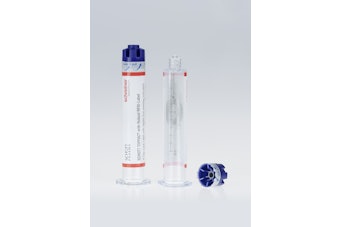The marketing value of packaging is a largely untapped frontier in over-the-counter pharmaceuticals. Packages delivering cognitive value can support a great product�and drive sales.
Terms like �metered dosage� and �clinical trial� are staples of healthcare products. But for savvy marketers competing in the evolving OTC pharmaceutical industry, concepts such as �sensory branding� and �transformative experience� are becoming essential additions to the list.
Today�s healthcare product aisles are stocked with more products than ever, and drug companies will need to leverage the marketing power of packaging or risk failure. That�s the viewpoint of some of the nation�s foremost branding and design thinkers. They cite the following three recent examples of healthcare brands that maximize the marketing power of packaging.
� GlaxoSmithKline (GSK) Consumer Healthcare, Moon Township, PA, is marketing its new alli OTC weight-loss capsules in a consumer-friendly starter kit whose design delivers a sensory experience by presenting the brand as the consumer�s ally or friend during a weight-loss program (see story on page 24).
� New packaging for the Plan B emergency contraceptive reflects regulatory changes that now make the drug available in nonprescription form for women 18 and older. Barr Pharmaceuticals, Pomona, NY, markets the drug in packaging that is suitable both behind the pharmacy counter and on the store shelf, saving the company money with a single package. The carton�s soothing colors and focus on product benefits give women peace of mind about their purchase.
� VasoActive Pharmaceuticals, Danvers, MA, redesigned packaging for its three flagship OTC topical lotions to signal product efficacy and health benefits over competitive offerings.
These brands share the approach of leveraging packaging to tap the human senses and create brand perceptions. From a marketing perspective, opportunities then emerge for connecting with consumers on a much deeper cognitive level. Many marketers of food, beverage, and personal care products execute this tactic well. But GSK, Barr, and VasoActive are among the exceptions to the rule in healthcare products because many drug companies still generally view packaging primarily as a mundane product-protection device, according to veterans in the branding and design industry.
One of these veterans is Peter Clarke, who has been designing packages for decades for companies like Procter & Gamble and Heinz. By failing to also consider the power of package design�in which structure and graphics work together�pharmaceutical companies are limiting the marketing impact and sales of their products, says Clarke, president of Product Ventures .
�Many pharmaceutical companies are so focused on equipment stability and regulatory requirements that they haven�t even begun to think beyond that and about such things as package design,� Clarke says. �If there�s an industry that�s not doing it right, this is the untapped frontier.�
Rx to OTC
Why is package design important in healthcare products? First, branding experts say, consider that many products formerly available only with a prescription are now also introducing a nonprescription
format. And other pills, tablets, topical creams, and lotions have evolved into OTC products. For the first time, companies that make and market these products need to consider how they stack up against many competitors on the store shelf, where shoppers make their own purchase decisions. A well-designed package can make a product easier to find on crowded store shelves. Great design also cements the sale on an emotional level, where most pharmaceutical brands don�t operate. It can boost a shopper�s confidence in selecting the right product.
Packaging�s impact is underutilized in prescription medications as well. The right structure can make the package easier to operate and can also simplify the drug-taking ritual. Overlay effective colors and graphics, and a product moves into another dimension. Consumer confidence improves, and packaging goes beyond serving merely as a container. It also begins to justify a branded product�s higher price point versus a less-expensive generic alternative.
There may be a third reason to consider the impact of design, say contract packagers that are often called on to design, fill, and package healthcare products. Pharmaceutical companies are under pressure to introduce new drugs to bolster the bottom line. Most are smaller launches to niche audiences. Package design can play an essential role in building a sense of �community� quickly with target audiences.
GSK, Barr Pharmaceuticals, and VasoActive break through the clutter of sterile-looking healthcare packaging because each of them talked with consumers about their product wants and needs. These companies understand the value of package design in building shoppers� brand recognition and recall, and in justifying the retail price.
Alli weight-loss capsules
If there�s an irony in the dietary aids aisle, it�s that the shelves are bulging with products that look remarkably similar, in a category marketing the notion that personal image is everything. GSK is taking a different route by leveraging sensory perception to introduce alli as a branded diet-support system. Package design is essential in this strategy.
The impetus for the package design came when the company selected 400 overweight consumers to participate in research that shed light on the emotional aspects of dieting.
�It�s easy to look at alli as pills in a bottle,� says Donna Sturgess, global head of innovation at GSK Consumer Healthcare. �We got very deep into the consumer experience, and we found that weight loss is a very emotionally charged category. We needed alli to be an honest voice and a transparent brand�here�s what you can expect if you follow the instructions.�
With consumer research in hand, GSK developed packaging to gently guide consumers in the product�s use. The company markets alli in a starter kit�a two-piece plastic container and lid. Inside the container, a white thermoformed tray contains a bottle of 60-mg tablets in 60-, 90, or 120-count sizes, a pill-carrying case, product usage pamphlets, a daily journal, a calorie and fat counter, and Quick Facts cards. The graphics card in the kit provides information for accessing a personalized diet action plan at www.myalli.com.
The primary container and tray work on a sensory level. The white tray holding the product and collateral materials is easily viewed through the transparent lid. They are meant to be emotionally reflective as product users transform themselves during the dieting process.
�It puts forth a canvas so you can see yourself and create your own identity,� Sturgess says, citing similar packaging that has propelled Apple�s iPod brand. �We are harnessing the power of sensory perception for marketing. The idea is made concrete through the senses. It is really a fusion happening inside this space. We think we have humanized a drug.�
The four-color alli brandmark is prominent on the bottle�s white label. Different colors in the brand name correspond to the four emotional cornerstones of understanding the product and sustaining a product-use routine: What is alli? How does it work? What�s the plan? Are you ready?
With such attention to detail in the packaging, GSK believes the product�s price-value relationship is enhanced and warrants a retail price of $50 to $70 per kit.
Plan B emergency oral contraceptive
When Barr Pharmaceuticals was selling its Plan B birth control product in pharmacies, the brand was yet another in a long list that lacked true brand communication. But in August 2006, the company gained FDA approval to begin marketing Plan B as an OTC product as well. Barr decided that women 18 and older, who were old enough to purchase the product on the store shelf without a pharmacist�s guidance, needed a package that would provide functional benefits and reduce their purchase anxiety.
Barr enlisted the help of IQ Design in restaging the brand. The creative team settled on a money-saving single-carton design for both the prescription and OTC versions of the drug. The dual-label package contains two pieces. The outer sleeve, believed to be SBS, includes white space on the back panel for the prescription label when the drug is sold in prescription form to women 17 and younger. A hinged, billfold carton that also looks to be SBS contains two tablets enclosed with clear film inside a die-cut window on the billfold�s right panel.
From a consumer standpoint, the package, containing two 0.75-mg levonorgestrel tablets, makes Plan B more visually approachable when sold in either OTC or prescription form, says Carol Cox, Barr spokesperson.
�This was a deliberate decision for several reasons,� Cox says. �First, shelf space behind the counter in pharmacies is limited, and some pharmacies would not be able to accommodate shelving two separate products. Second, having a single package for the OTC and Rx product minimizes confusion for consumers and pharmacists. Third, the package has a new NDC [National Drug Code] number from the previously Rx-only product.�
The package also contains prescribing information and a patient information booklet explaining Plan B and how and when to take the tablets.
The brand is easily identified by the distinctive graphic design of the carton, from Sharp Corp.
�We wanted the packaging design to have a confident and feminine feel to it,� says Leslie Tucker, IQ Design principal and chief creative officer. A proprietary logotype overlays a custom color design with a blue-violet background that gives way to a circular graphic using darker tones of the same colors. Printing is done in six colors. A side-by-side bright-green swoosh bleeds off the carton. The effect exudes youth, and it calms and reassures women about their product selection, Tucker says.
IQ Design created custom spot-channel color separations for both the outer sleeve and billfold to provide brilliant graphic reproduction.
�It creates wholeness, a sense that a woman could take this product and get her life back,� says Leslie Tucker, principal and chief creative officer at IQ Design.
OTC topical lotions
VasoActive Pharmaceuticals gained additional market distribution for its three OTC topical lotions�Termin-8 (for athlete�s foot), A-R Extreme (for temporary relief from minor sports-related muscular and skeletal injuries), and Osteon (for osteoarthritis and other muscle and joint pain)�by redesigning the packaging for more vibrancy, dimension, and color-coding. The company now complements its online distribution by making the products available in supermarkets, drug stores, discount health and beauty stores and independent pharmacies in NY, NJ, and CT.
Conceptualized by Wright Design, the new packaging suggests that each product belongs to the VasoActive family while also differentiating them in a way to appeal to their particular target audience. The designs minimize the use of white and incorporates foil stamping and embossing to help each product stand out on store shelves.
�We think the new packaging graphics truly reflect the power and efficacy of these unique products,� notes Stephen Cataldo, VasoActive marketing director. �We�ve only been out for a short time, and now we�re already receiving reorder requests. That�s a great sign.�
The three lotions, Cataldo says, incorporate proprietary PENtoCore lipid encapsulated technology that aids product penetration through the skin. The package design reflects this benefit through a silver-and-green logo and with reverberating �waves� that are color-coded for Termin-8, A-R Extreme, and Osteon.
By Jim George Editor, Shelf Impact
Swim against the tide to build OTC brands through design
The marketing value of packaging is a largely untapped frontier in OTC pharmaceuticals.
Oct 15, 2007
List: Digitalization Companies From PACK EXPO
Looking for CPG-focused digital transformation solutions? Download our editor-curated list from PACK EXPO featuring top companies offering warehouse management, ERP, digital twin, and MES software with supply chain visibility and analytics capabilities—all tailored specifically for CPG operations.
Download Now
Researched List: Blister Machines for Life Sciences
Need a blister machine for life sciences packaging? Our curated list features companies serving pharmaceutical, medical device, nutraceutical, and cosmetic industries. Download to access company names, locations, machine specifications, descriptions, and more.
Download Now
Downloads

















